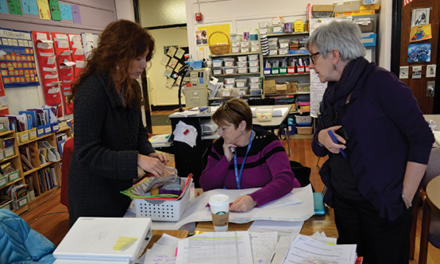A preoccupation with charter schools and vouchers has blinded us to other options.
Should parents be able to choose a school for their child? In some countries, the answer to this question would be a quizzical, “No, why would they?” In Finland, for instance, public schools tend to be so similar in their curriculum, pedagogy, and quality that it would make no sense to enroll your children in any school but the nearest one. But in the United States, schools (even in the same neighborhood) often vary in their quality, reputation, resources, curriculum, instruction, and more; and multiple systems of schooling — public, private, parochial — offer options to parents.
Over the last few decades, calls for more school choice have won bipartisan support among Americans, blurring the ideological lines that divide us on most other issues. From the presidency of George H.W. Bush to that of Barack Obama, choice models that focused on vouchers and charter schooling, especially, resonated with significant numbers of parents from all racial, economic, and political backgrounds; with business magnates; and even, to an extent, teachers unions (Schneider & Berkshire, 2020).
But different forms of choice advance different visions of who should get to make what kinds of choices. And the more we’ve wrestled over who stands to benefit from each approach to school choice, the more the political coalition of recent decades has begun to fall apart. Increasingly, and as we saw during the four years of the Trump administration, conservatives have come to favor tuition tax credits and voucher programs, which are meant to help parents pay for private schooling, while progressives have rallied around investment in public schools, which leads them to favor forms of school choice, such as magnet schooling and districtwide choice, that aim to keep students (and public funds) within the public system.
Partisan conflict over school choice is, in fact, older than the Republic itself (Kaestle, 1983), and it has always been grounded in deeper questions about Americans’ core values and beliefs: What do children need from their schools, and who is best equipped to determine what they need? Do we want our schools to create a meritocracy — sorting children into winners and losers — or do we want them to promote equality (or at least make sure every child has an equal chance to win)? Should they teach a strictly secular curriculum, or should they allow for religious instruction? In short, debates about school choice in the U.S. have been wide-ranging and complex, and they’ve wrestled with big, unresolved tensions that lie at the heart of American life, having to do with individual rights, community obligations, public and private interests, religious freedoms, and more.
Debates about school choice in the U.S. have wrestled with big, unresolved tensions that lie at the heart of American life.
Today, though, policy makers tend to talk about “choice” as though it were nothing more than a code word for vouchers and charter schools. Advocates say that choosing a school is a fundamental parental prerogative, that parents know what is best for their children, and that if parents are allowed to make such choices, free from governmental intrusion, then schools will be forced to become more efficient, more responsive to communities and families, and better overall (Chubb & Moe, 1990). As a result, school choice has been reduced to a couple of simple for/against propositions: Do you think parents should have the right to select the best available school, or not? Do you think market competition can benefit the education sector, or not? And those who oppose vouchers, argue that charters should be regulated, or stand up for the idea that schools are public institutions, in which the community has a significant stake, have been branded as “anti-choice.”
This framing ignores the bigger picture of school choice in the U.S. and misses most of its nuances. It presents an idealized version of an educational marketplace that some people find attractive, but it doesn’t address the realities that most people face or the questions they ask when their child reaches school age. Given the country’s remarkable diversity, there is little reason to think that we can come up with “one best” model of schooling that fits all children, families, and communities. But our values are still reflected in the schooling options available to parents in different communities.
Simply put, it’s time we get over the idea that school choice is something new in American education or that it refers only to using a voucher or signing children up for a charter school. To focus on such a narrow set of choices only distracts from efforts to address our underlying tensions over how to define and respond to children’s needs, how to square the rights of families with the interests of the state, and how to balance educational quality, equity, and accountability. If we’re going to have a truly informed debate about school choice, then we need to start by taking a more expansive look at the various options children and families actually pursue.
What kinds of choice are most prevalent today?
There never was a golden age of American unity, when a public school anchored every community and provided the same curriculum and instruction to every child. Rather, K-12 students have always attended a wide range of public, private, for-profit, and charitably supported institutions (Ben-Porath & Johanek, 2019).
The National Center for Education Statistics (NCES) reports that as of 2016, the most recent year for which such data are available, 3.3% of school-age children were homeschooled. (More recent trends suggest that the percentage has climbed somewhat since then, and that it increased even more after schools closed due to COVID; but we don’t yet know whether the pandemic will have a long-term effect on rates of homeschooling.)
Policy makers tend to talk about “choice” as though it were nothing more than a code word for vouchers and charter schools.
Among children who are not homeschooled, just under 10% attend private schools (a proportion that has held more or less steady for about two centuries) and, for the most part, their parents cover the cost of tuition (unless otherwise noted, all data in this section are from NCES, 2019). In recent decades, school vouchers — and related approaches to using public funds to support private school enrollment, including tax credit programs and education savings accounts — have gained some prominence in education policy debates (Carl, 2011), and expanding them (especially the use of vouchers and tax credits to pay tuition at religious schools) was a priority of the Trump administration. However, according to the pro-choice advocacy group EdChoice, these programs account for only about 1% of student enrollments in the U.S. (Shaw & Catt, 2021).
The vast majority of non-homeschooled children in the U.S, almost 90%, attend a public school (a proportion that has been fairly consistent for four decades). While most of those students attend the neighborhood school to which they were assigned, roughly 20% are enrolled in a public school of choice, meaning a public school other than their zoned or assigned one. That includes the roughly 5% who attend magnet schools (which tend to enroll students from a broader area, and which often specialize in science, technology, or another field of study) and the 5-7% who attend charter schools (both nonprofit and for-profit), which are mostly concentrated in urban areas.
Most parents express satisfaction with their child’s public school, and 6 in 10 parents say they would keep their child in the same school even if cost was not a concern (PDK International, 2020). And while the pandemic may have led some parents to change their views, the 2021 PDK poll, released in this issue of Kappan, suggests that parents’ approval of their local schools remains strong overall.
However, policy debates about school choice tend to leave out one other important piece of the puzzle: The main form of choice pursued by American parents is, and long has been, residential selection. Families that have the means to do so tend to move to a neighborhood with desirable public schools (and, of course, since home values and school funding are tightly linked, it’s a good bet that those schools will remain desirable over time; Lareau, 2014; Ryan, 2011). Note, however, that the policy recommendations most often associated with school choice — expanding voucher programs and charter school enrollments — do very little to change this dynamic since private schools are under no obligation to accept vouchers and charter schools mostly operate within districts, which rarely encompass both affluent and poor neighborhoods.
To this day, President Richard Nixon’s famous 1972 “compromise” — his proposal to “save the city” (by improving urban schools that enroll mainly Black and brown students) and “spare the suburbs” (from school integration) — continues, despite its ugly racial undertones, to shape policy debates in this area. And the racial chasm separating urban and suburban neighborhoods became even wider following the U.S. Supreme Court’s decisions in Milliken vs. Bradley (1974), which held that district attendance zones exploited by residential segregation could be enforced, and Parents Involved in Community Schools (2007), which prevented school districts from considering race in (re)drawing attendance zones. In effect, these decisions have protected the interests of affluent families, ensuring the exclusivity of the schools they’ve chosen via residential selection (and segregation). They’ve already claimed the largest piece of the educational pie; debates about “school choice” have to do with divvying up whatever’s left.
By and large, voucher programs and charter schools have failed to provide truly meaningful options for families who haven’t been able to choose schools through residential selection. For instance, many school systems, especially in rural areas, are too small to offer a choice — if there’s only one school in the area, that’s the one you attend. And in larger districts that do offer choices, many parents lack the resources to visit schools, assess their pros and cons, and prepare applications, or they cannot afford the cost of private school tuition (even with a voucher or tax credit). Moreover, in the relatively few school systems that include both rich and poor families (mainly big cities like New York City and Washington, D.C.), well-to-do parents — at least those who remain in the public system — have often found ways to take advantage of the district’s limited options by, for example, pushing for their children to get into gifted programs, applying to multiple charter schools, and paying for test-prep classes and tutors to help their children gain admission to specialized schools that rely on entrance exams. In this way, the promise of choice for all becomes, in reality, a benefit for the few.
In short, charters and vouchers often fail to add up to “more choice” in any meaningful sense, such as a choice among schools that are equal in quality but varied in their curriculum and instruction. Rather, they entail a reshuffling of available resources, where some “high-quality” schools become even more desirable and other schools become even less so. And when the time comes to make “choices” — more accurately, to compete with others in the district to get into the most desirable schools — the neediest families and most vulnerable children tend to find themselves at a serious disadvantage, struggling to navigate the applications, interviews, school visits, and examinations that determine who will gain access. Even charter school lottery systems, which aim to level the playing field, tend to be more difficult for the most distressed families to manage. As a result, their children tend to remain concentrated in the lowest-performing schools. And on the whole, there’s little evidence to suggest that charters, vouchers, and similar choice programs elevate the level of success or satisfaction among poor and racial/ethnic minority students and parents, or that they improve overall school quality.
School reformers often romanticize the notion that tired old school systems need to be “disrupted” in order to be improved. But when charters and voucher programs shake up school districts, they can do more harm than good, creating disarray in the lives of students whose schools close down at a moment’s notice (Nuamah, in press); undermining trust in a system that relies on long-term relationships among educators, parents, and community members (Ewing, 2018), and deepening the divide between those who’ve “won” the competition for spots in the most desirable schools and those who’ve lost out.
As should be evident from this summary, a wide gulf exists between the policy talk about “school choice” in the U.S. and the realities of who gets to make beneficial educational choices. Advocates have spent years calling attention to policy strategies (i.e., charters and vouchers) that play a fairly minor role in most school systems, while the much more important issue (school choice by means of residential selection) goes largely undiscussed.
It’s time to reframe the debate
As the pandemic has illustrated so clearly, Americans depend upon their public schools for far more than academic instruction. When they cannot attend school in person, millions of students lose access to social and emotional supports, learning materials and tools, health care, food, and more. And virtual schools, while attractive to some families, threaten to further segregate communities and isolate underserved students.
Whatever else we learn from the COVID crisis, the inequities that it has exposed should force us to rethink age-old assumptions about the kinds of educational choices, and the quality of schooling, that ought to be made available to all students and their families. So, too, should it force us to reckon with decades of state and federal policy strategies that have served to circumvent the promise of Brown v. Board of Education, leaving our schools racially and economically segregated.
A wide gulf exists between the policy talk about “school choice” in the U.S. and the realities of who gets to make beneficial educational choices.
It’s time to reset the whole debate about school choice, returning to more fundamental questions about how best to balance the competing demands we place on our schools: What do children need? What do families want? And how can we ensure that the system is equitable, accountable, and able to provide quality schooling for all? For too long, the preoccupation with charter schools and vouchers has blinded us to other options that don’t force families to compete for limited spots in the “best” schools, but that offer meaningful choices for all families.
Options for students
Historically, one of the main sources of tension in American education has had to do with the kinds and amount of choice given to individual students. To what extent should they be required to complete a lockstep course of study, and to what extent should they be free to choose their own path? To what extent do families and communities have an interest in controlling what young people learn, and how much power should they have to enforce this control? Even as federal and state authorities exert growing control over the substance and pace of learning (Henig, 2013), shouldn’t students have a say not simply in where they attend school but also in what and how they learn?
If you visit well-funded suburban districts, it’s not hard to find schools that strike a balance, providing a structured and coherent curriculum while also allowing students to make a range of individual choices, based on their needs and interests: They can join small learning communities organized around a theme or pedagogical approach; use resource rooms that support children with differing learning needs; sign up for after-school clubs and teams; enroll in an Advanced Placement class or International Baccalaureate program, or opt for a technical or early college program.
Such schools offer many of the things that Americans tend to want from their schools. They balance discipline with freedom; they are free and therefore accessible regardless of family income; they allow students to stay close to home (which is a major consideration especially for younger children), and — if their zones are mapped thoughtfully or if they are magnets drawing from diverse areas (Frankenberg & Siegel-Hawley, 2008) — they can be inclusive, diverse settings. (And, ideally, they avoid tracking students in ways that end up segregating them by race or income within the school; Tyson, 2011.) No, they cannot respond to all of the choices families might want — for example, they cannot provide religious instruction — but they respond to a lot of them. Further, they do so while abiding by state and federal guidelines that protect students’ civil rights, ensure teachers’ qualifications, and establish specific learning standards, all of which most parents favor.
Helping larger numbers of urban and rural schools to offer similar opportunities would do far more than current policies to address Americans’ demands for greater choice. The prevailing logic of school reform holds that parents should be able to take their children out of a bad school and enroll them in a better one. But this does nothing to ensure that either the bad school or the “better” one is, in fact, responsive to children and families’ needs, balancing their desires for structure, freedom, quality, convenience, inclusion, and more. The priority should be to help every school provide its students with meaningful choices and opportunities, just as the best public schools already do, rather than giving a few lucky children the chance to attend a “choice school.”
Beyond boundaries: Options for families
As long as residential selection remains the most powerful means of choosing a school, within-district school choice policies will give, at most, a tiny fraction of rural and urban low-income parents the kinds of options that everybody would like to have for their children. Further, in big-city districts, those choices are often co-opted by relatively affluent families, who are better positioned to seize the available options and opportunities.
If reformers are truly interested in leveling the playing field and providing meaningful choices to all children and parents, then they will have to stop pretending that choice alone can accomplish this within existing school district boundaries. Struggling urban and rural districts can certainly do more to create diverse curricular pathways within their schools and to ensure more equitable access to the most desirable schools, but they will never be able to provide the options that are available in wealthier school systems — not unless their students can cross attendance zones.
As a start, policy makers ought to give more attention to magnet schools, which have received much less publicity than charter schools in recent years, even though they enroll nearly as many students and have a history of providing effective and meaningful choice. For example, reformers might look to cities such as Montclair, New Jersey, and Hartford, Connecticut, which have not only created multiple magnet schools (each devoted to a specific academic theme) but also created flexible zoning areas that allow diverse families from outside the district to take advantage of these options. As a strategy for desegregating public education and providing more children with better choices and opportunities, magnet schools have had mixed success. But unlike charter schools, they allow for shared funding and oversight among district, state, and federal officials, making it possible to blur the district boundaries and attendance zones that have otherwise been difficult for families to cross. And unlike the prevailing approaches to school choice, which treat education strictly as a means of individual advancement, the magnet approach starts from the premise that education is a mixed public/private good (Levin, 2009) that should meet parents’ desire to see their own children succeed, while also meeting the needs of the larger community to educate all children to a high standard.
Get real: Money matters
We cannot expect vouchers and charter schools to accomplish anything like the outcomes their supporters have promised over the decades. School choice is not a magical mechanism for educational transformation, promoting equality and efficiency, parental authority, religious freedom, fairness, innovation, accountability, and so on. The fact is that current forms of school choice in the U.S. mostly benefit those who are already well-off, who can move to the catchment area of a desirable public school, who can pay private school tuition, and who have the means to work the charter or exam school admissions process.
Realistically, the only way to create more and better choices for all families, including those in struggling rural and urban school systems, is for state and federal officials to make much greater investments in those systems. Ultimately, if we want low-income parents and their children to have anything like the choices and opportunities found in affluent suburban and private schools, then we’ll have to do more than innovate and disrupt, and we’ll have to acknowledge that “school choice” that benefits the lucky few, while siphoning opportunity from everybody else, is a poor choice indeed.
References
Ben-Porath, S. & Johanek, M. (2019). Making up our mind: what school choice is really about. University of Chicago Press.
Carl, J. (2011). Freedom of choice: Vouchers in American education. Praeger.
Chubb, J.E. & Moe, T.M. (1990). Politics, markets, and America’s schools. Brookings Institution.
Ewing E.L. (2018). Ghosts in the schoolyard: Racism and school closing on Chicago’s South Side. University of Chicago Press.
Frankenberg, E. & Siegel-Hawley, G. (2008). Rethinking magnet schools in a changing landscape: A report to Magnet Schools of America. University of California at Los Angeles, Civil Rights Project.
Henig, J. (2013). The end of exceptionalism in American education: The changing politics of school reform. Harvard Education Press.
Kaestle, C.F. (1983). Pillars of the republic: Common schools and American society, 1780–1860. Hill and Wang.
Lareau, A. (2014). Schools, housing, and the reproduction of inequality. In A. Lareau & K. Goyette (Eds.), Choosing homes, choosing schools. Russell Sage.
Levin, H.R. (2009). An economic perspective on school choice. In M. Berends (Ed.), Handbook of research on school choice. Taylor & Francis.
National Center for Education Statistics. (2019). Digest of educational statistics: 2019. U.S. Department of Education.
Nuamah, S. (in press). Closed for democracy. Cambridge University Press.
PDK International. (2020). Public school priorities in a political year: PDK poll of the public’s attitudes toward the public schools. Author.
Ryan J.E. (2011). Five miles away, a world apart. Oxford University Press.
Schneider, J. & Berkshire, J. (2020). Wolf at the schoolhouse door. New Press.
Shaw, M. & Catt, D. (2021, April 14). 2021 EdChoice Share: Where are America’s students getting their education? Engage by EdChoice.
Tyson, K. (2011). Integration interrupted: Tracking, Black students, and acting white after Brown. Oxford University Press.
ABOUT THE AUTHOR

Sigal Ben-Porath
Sigal Ben-Porath is a professor of education at the University of Pennsylvania, where she is an affiliate of the philosophy department, the political science department, and the Institute for Law and Philosophy. She is coauthor, with Michael Johanek, of Making Up Our Mind: What School Choice is Really About.










